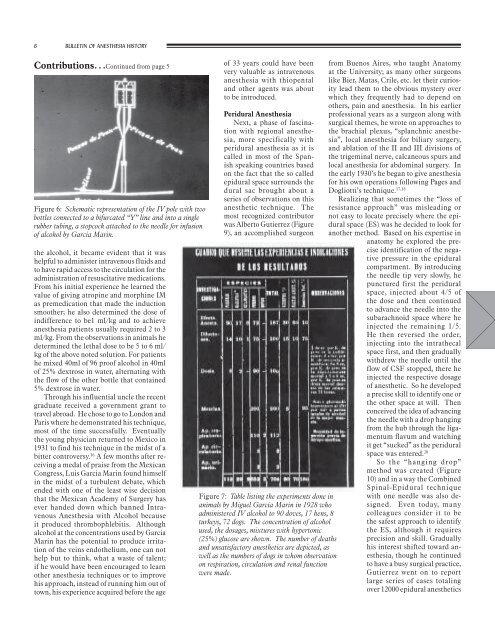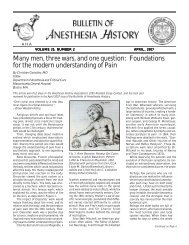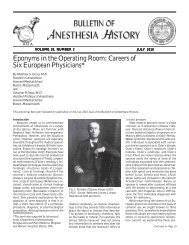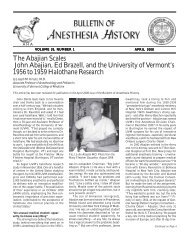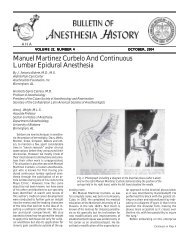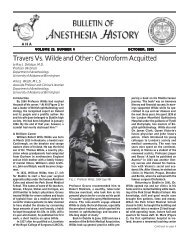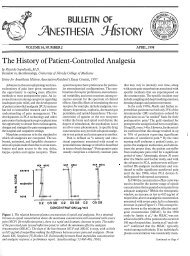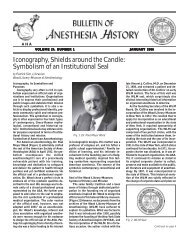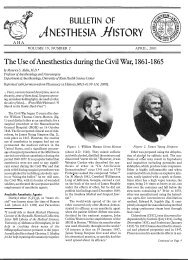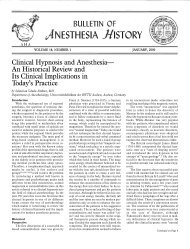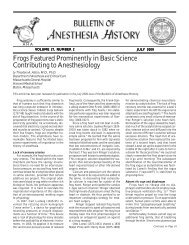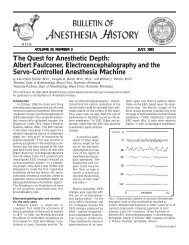Original Contributions of Latin-Ameri- cans to Anesthesia
Original Contributions of Latin-Ameri- cans to Anesthesia
Original Contributions of Latin-Ameri- cans to Anesthesia
Create successful ePaper yourself
Turn your PDF publications into a flip-book with our unique Google optimized e-Paper software.
6 BULLETIN OF ANESTHESIA HISTORY<br />
<strong>Contributions</strong>. . .Continued from page 5<br />
Figure 6: Schematic representation <strong>of</strong> the IV pole with two<br />
bottles connected <strong>to</strong> a bifurcated “Y” line and in<strong>to</strong> a single<br />
rubber tubing, a s<strong>to</strong>pcock attached <strong>to</strong> the needle for infusion<br />
<strong>of</strong> alcohol by Garcia Marin.<br />
the alcohol, it became evident that it was<br />
helpful <strong>to</strong> administer intravenous fluids and<br />
<strong>to</strong> have rapid access <strong>to</strong> the circulation for the<br />
administration <strong>of</strong> resuscitative medications.<br />
From his initial experience he learned the<br />
value <strong>of</strong> giving atropine and morphine IM<br />
as premedication that made the induction<br />
smoother; he also determined the dose <strong>of</strong><br />
indifference <strong>to</strong> be1 ml/kg and <strong>to</strong> achieve<br />
anesthesia patients usually required 2 <strong>to</strong> 3<br />
ml/kg. From the observations in animals he<br />
determined the lethal dose <strong>to</strong> be 5 <strong>to</strong> 6 ml/<br />
kg <strong>of</strong> the above noted solution. For patients<br />
he mixed 40ml <strong>of</strong> 96 pro<strong>of</strong> alcohol in 40ml<br />
<strong>of</strong> 25% dextrose in water, alternating with<br />
the flow <strong>of</strong> the other bottle that contained<br />
5% dextrose in water.<br />
Through his influential uncle the recent<br />
graduate received a government grant <strong>to</strong><br />
travel abroad. He chose <strong>to</strong> go <strong>to</strong> London and<br />
Paris where he demonstrated his technique,<br />
most <strong>of</strong> the time successfully. Eventually<br />
the young physician returned <strong>to</strong> Mexico in<br />
1931 <strong>to</strong> find his technique in the midst <strong>of</strong> a<br />
bitter controversy. 16 A few months after receiving<br />
a medal <strong>of</strong> praise from the Mexican<br />
Congress, Luis Garcia Marin found himself<br />
in the midst <strong>of</strong> a turbulent debate, which<br />
ended with one <strong>of</strong> the least wise decision<br />
that the Mexican Academy <strong>of</strong> Surgery has<br />
ever handed down which banned Intravenous<br />
<strong>Anesthesia</strong> with Alcohol because<br />
it produced thrombophlebitis. Although<br />
alcohol at the concentrations used by Garcia<br />
Marin has the potential <strong>to</strong> produce irritation<br />
<strong>of</strong> the veins endothelium, one can not<br />
help but <strong>to</strong> think, what a waste <strong>of</strong> talent;<br />
if he would have been encouraged <strong>to</strong> learn<br />
other anesthesia techniques or <strong>to</strong> improve<br />
his approach, instead <strong>of</strong> running him out <strong>of</strong><br />
<strong>to</strong>wn, his experience acquired before the age<br />
<strong>of</strong> 33 years could have been<br />
very valuable as intravenous<br />
anesthesia with thiopental<br />
and other agents was about<br />
<strong>to</strong> be introduced.<br />
Peridural <strong>Anesthesia</strong><br />
Next, a phase <strong>of</strong> fascination<br />
with regional anesthesia,<br />
more specifically with<br />
peridural anesthesia as it is<br />
called in most <strong>of</strong> the Spanish<br />
speaking countries based<br />
on the fact that the so called<br />
epidural space surrounds the<br />
dural sac brought about a<br />
series <strong>of</strong> observations on this<br />
anesthetic technique. The<br />
most recognized contribu<strong>to</strong>r<br />
was Alber<strong>to</strong> Gutierrez (Figure<br />
9), an accomplished surgeon<br />
Figure 7: Table listing the experiments done in<br />
animals by Miguel Garcia Marin in 1928 who<br />
administered IV alcohol <strong>to</strong> 90 doves, 17 hens, 8<br />
turkeys, 72 dogs. The concentration <strong>of</strong> alcohol<br />
used, the dosages, mixtures with hyper<strong>to</strong>nic<br />
(25%) glucose are shown. The number <strong>of</strong> deaths<br />
and unsatisfac<strong>to</strong>ry anesthetics are depicted, as<br />
well as the numbers <strong>of</strong> dogs in whom observation<br />
on respiration, circulation and renal function<br />
were made.<br />
from Buenos Aires, who taught Ana<strong>to</strong>my<br />
at the University; as many other surgeons<br />
like Bier, Matas, Crile, etc. let their curiosity<br />
lead them <strong>to</strong> the obvious mystery over<br />
which they frequently had <strong>to</strong> depend on<br />
others, pain and anesthesia. In his earlier<br />
pr<strong>of</strong>essional years as a surgeon along with<br />
surgical themes, he wrote on approaches <strong>to</strong><br />
the brachial plexus, “splanchnic anesthesia”,<br />
local anesthesia for biliary surgery,<br />
and ablation <strong>of</strong> the II and III divisions <strong>of</strong><br />
the trigeminal nerve, calcaneous spurs and<br />
local anesthesia for abdominal surgery. In<br />
the early 1930’s he began <strong>to</strong> give anesthesia<br />
for his own operations following Pages and<br />
Dogliotti’s technique. 17,18<br />
Realizing that sometimes the “loss <strong>of</strong><br />
resistance approach” was misleading or<br />
not easy <strong>to</strong> locate precisely where the epidural<br />
space (ES) was he decided <strong>to</strong> look for<br />
another method. Based on his expertise in<br />
ana<strong>to</strong>my he explored the precise<br />
identification <strong>of</strong> the negative<br />
pressure in the epidural<br />
compartment. By introducing<br />
the needle tip very slowly, he<br />
punctured first the peridural<br />
space, injected about 4/5 <strong>of</strong><br />
the dose and then continued<br />
<strong>to</strong> advance the needle in<strong>to</strong> the<br />
subarachnoid space where he<br />
injected the remaining 1/5.<br />
He then reversed the order,<br />
injecting in<strong>to</strong> the intrathecal<br />
space first, and then gradually<br />
withdrew the needle until the<br />
flow <strong>of</strong> CSF s<strong>to</strong>pped, there he<br />
injected the respective dosage<br />
<strong>of</strong> anesthetic. So he developed<br />
a precise skill <strong>to</strong> identify one or<br />
the other space at will. Then<br />
conceived the idea <strong>of</strong> advancing<br />
the needle with a drop hanging<br />
from the hub through the ligamentum<br />
flavum and watching<br />
it get “sucked” as the peridural<br />
space was entered. 20<br />
So the “hanging drop”<br />
method was created (Figure<br />
10) and in a way the Combined<br />
Spinal-Epidural technique<br />
with one needle was also designed.<br />
Even <strong>to</strong>day, many<br />
colleagues consider it <strong>to</strong> be<br />
the safest approach <strong>to</strong> identify<br />
the ES, although it requires<br />
precision and skill. Gradually<br />
his interest shifted <strong>to</strong>ward anesthesia,<br />
though he continued<br />
<strong>to</strong> have a busy surgical practice,<br />
Gutierrez went on <strong>to</strong> report<br />
large series <strong>of</strong> cases <strong>to</strong>taling<br />
over 12000 epidural anesthetics


